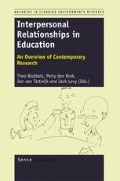Abstract
Research supports that bullying often goes unnoticed in schools, especially at the elementary level. Dan Olweus, an expert and Norwegian researcher began studying bullying in the 1970s and continues his work today. The bulk of early research on bullying generally indicates younger children are bullied more than older children and declines as children get older (Hoover, Oliver, & Hazler, 1992; Rigby & Slee, 1991; Ziegler & Rosenstein-Manner, 1991; Zindi, 1994).
Access this chapter
Tax calculation will be finalised at checkout
Purchases are for personal use only
Preview
Unable to display preview. Download preview PDF.
References
Athanasiades C, Deliyanni-Kouimtzis V. The experience of bullying among secondary school students. Psychology in the Schools. 2010;47(4):328–341.
Batsche GM, Knoff HM. Bullies and their victims: Understanding a pervasive problem in the schools. School Psychology Review. 1994;23:165–175.
Baxter, D. J. (2004, May 12). Re: Bullying starts at young age [Blog Thread]. Retrieved from http://forum.psychlinks.ca/bullying-harassment-and-interpersonal-violence/192-bullying-starts-at- young-age.html.
Bidwell, N. M. (1997, May). The nature and prevalence of bullying in elementary schools (SSTA Research Center Report No. 97-06). Regina, Saskatchewan: Saskatchewan School Trustee Association.
Bonds M, Stoker S. Bullyprofing your school. Longmont, CO: Sopris West; 2000.
Boulton MJ. Teachers' views on bullying: definitions, attitudes and ability to cope. British Journal of Educational Psychology. 1997;67:223–233.
Boulton JJ, Underwood K. Bully/victim problems among middle school children. British Journal of Education Psychology. 1992;62:73–87.
Cook, C. R., Williams, K. R., Guerra, N. G., Kim, T. E., & Sadek, S. (2010). Predictors of bullying and victimization in childhood and adolescence: A meta-analytic investigation. School Psychology Quarterly, 25(2), 65-83. doi:10.1037/a0020149; 10.1037/a0020149.supp (Supplemental).
Faulds, G. (2001). Victims of school bullies say they don't receive help. Reuters Health. Retrieved from www.rense.com.
Fried S. Bullies and victims: helping your child through the schoolyard battlefield. Kansas City: MO; 1996.
Gale Encyclopedia of Childhood & Adolescence. (1998). Gale Research, in association with The Gale Group and Look Smart.
Garrity C, Jens K, Porter WW, Sager N, Short-Camilli C. Bullying-profing your school: Creating a positive climate. Intervention in School and Clinic. 1997;32(4):235–243.
Hay C, Meldrum R. Bullying victimization and adolescent self-harm: Testing hypotheses from general strain theory. Journal of Youth and Adolescence. 2010;39(5):446–459. doi:10.1007/s10964- 009-9502-0.
Hinduja, S. & Patchin, J. W. (2010). Cyberbullying fact sheet: Identification, prevention, and response. Cyberbullying Research Center. Retrieved January 30, 2011, from http://www.cyberbullying.us/ Cyberbullying_Identification_Prevention_Response_Fact_Sheet.pdf.
Hoover JH, Oliver R. The bullying prevention handbook: A guide or principals, teachers, and counsellors. Bloomington, In: National Educational Service; 1996.
Hoover, J. H., Oliver, R., & Hazler, R. J. (1992). Bullying: Perceptions of adolescent victims in the Midwestern U.S.A. School Psychology International, 13(1), 5-16.
Huesmann LR, Eron LD, Guerra NG, Crawshaw VB. Measuring children's aggression with teachers' predictions of peer nominations. Psychological Assessment. 1994;6:329–336.
Kaminski JW, Fang X. Victimization by peers and adolescent suicide in three US samples. Journal of Pediatrics. 2009;5:683–8.
Lee F. Facing the fire: Experiencing and expressing anger appropriately. New York: Bantam Books; 1993.
Loeber R, Hay D. Key issues in the development of aggression and violence from childhood to early adulthood. Annual Review of Psychology. 1997;48:371–410.
Maine Project Against Bullying. (2000). A survey of bullying behaviour among Maine third graders [Electronic fact sheet]. Wiscasset, ME: Wiscasset Elementary School. Available: http://lincoln.midcoast.com/~wps/against/bullying.html [Retrieved: December 8, 2003].
Mellor A. Finding out about bullying. Scottish Council for Research in Education Spotlights. 1993;43:1–3.
Olweus, D. (1987, Fall). Schoolyard bullying - Grounds for intervention. School Safety, 411.
Olweus D. Bully/victim problems among school children: Basic facts and effects of a school based intervention program. In: Rubin I, Pepler E, editors. The development and treatment of childhood aggression. Hillsdale, NJ: Erlbaum; 1991. p. 411–447.
Olweus D. Bullying at school: What we know and what we can do. Cambridge, MA: Blackwell; 1993.
Olweus D. Bullying at school: Long-term outcomes for the victims and an effective school- based intervention program. In: Huesmann LR, editor. Aggressive behaviour: Current perspectives. New York: Plenum; 1994. p. 97–130.
Olweus D, Limber SP. Bullying in school: Evaluation and dissemination of the Olweus bullying prevention program. American Journal of Orthopsychiatry. 2010;80(1):124–134. doi:10.1111/j.1939-0025.2010.01015.x.
Patterson GR, Reid JB, Dishion TJ. A social interactional approach: IV. Antisocial boys. Eugene, OR: Castalia Press; 1992.
Pepler DJ, Craig WM. About bullying. Understanding this underground activity. Orbit. 1995;25(3):32–34.
Perry DG, Kusel SJ, Perry IC. Victims of peer aggression. Developmental Psychology. 1988;24:807–814.
Rigby K, Slee PT. Bullying among Australian school children: Reported behaviour and attitudes towards victims. Journal of Social Psychology. 1991;131:615–627.
Rodkin PC, Gest SD. Teaching practices, classroom peer ecologies, and bullying behaviours among schoolchildren. In: Espelage DL, Swearer SM, editors. Bullying in North American schools. 2nd ed. New York, NY: Routledge; 2011. p. 75–90.
Snyder AW. Autistic genius. Nature. 2004;429:470–471.
Sprague, J. & Walker, H. (2000). Early identification and intervention for youth with antisocial and violent behaviour. Exceptional Children; Reston, 3, 367-379.
Stanford University Medical Center [RxPG]. (2007, April). School bullying affects majority of elementary students. Reviewed by Vidyarthi, Retrieved from Behavioural Science Channel website: http://www.rxpgnews.com/behaviouralscience/School_bullying_affects_majority_of_elementary_st udents_23451.shtml.
Swearer SM, Cary PT. Perceptions and attitudes toward bullying in middle school youth: A developmental examination across the bully/victim continuum. Journal of Applied School Psychology. 2003;19(2):63–79. doi:10.1300/J008v19n02_05.
Walker HM. Anti-social behaviour in school. Journal of Emotional and Behavioural Problems. 1993;2(1):20–24.
Weinhold BK, Weinhold JB. Conflict resolution: The partnership way in schools. Counseling and Human Development. 1998;30(7):1–2.
Whitney I, Smith PK. A survey of the nature and extent of bullying in junior/middle and secondary schools. Educational Research. 1993;35:3–25.
Ziegler S, Rosenstein-Manner M. Bullying at school: Toronto in an inter-national context. Toronto: Toronto Board of Education, Research Services; 1991.
Zindi F. Bullying at boarding school: a Zimbabwe study. Research in Education. 1994;51:23–32.
Rights and permissions
Copyright information
© 2012 Sense Publishers
About this chapter
Cite this chapter
Mcgee, J.M. (2012). An Observational Study of Teachers’ Affilliation and Control Behaviours towards Kindergarten Children. In: Interpersonal Relationships in Education. Advances in Learning Environments Research, vol 3. SensePublishers, Rotterdam. https://doi.org/10.1007/978-94-6091-939-8_5
Download citation
DOI: https://doi.org/10.1007/978-94-6091-939-8_5
Publisher Name: SensePublishers, Rotterdam
Online ISBN: 978-94-6091-939-8
eBook Packages: Humanities, Social Sciences and LawEducation (R0)

